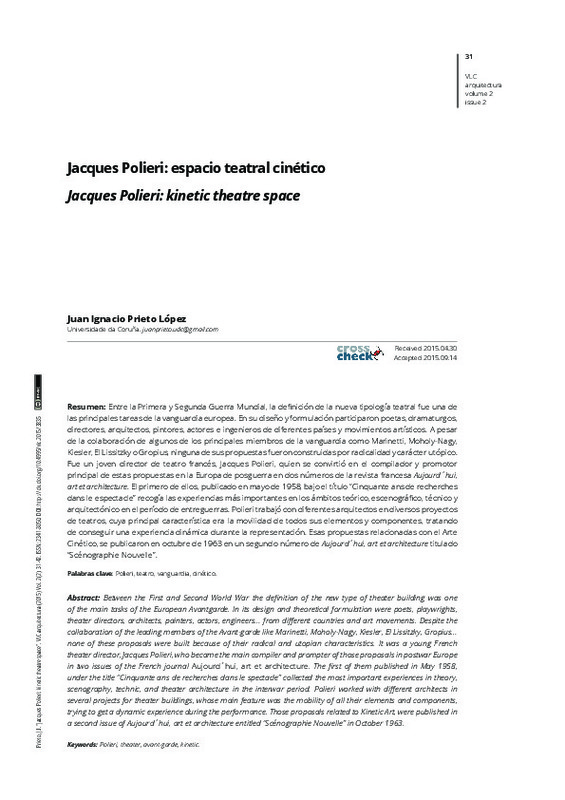JavaScript is disabled for your browser. Some features of this site may not work without it.
Buscar en RiuNet
Listar
Mi cuenta
Estadísticas
Ayuda RiuNet
Admin. UPV
Jacques Polieri: Kinetic Theatre Space
Mostrar el registro sencillo del ítem
Ficheros en el ítem
| dc.contributor.author | Prieto López, Juan Ignacio
|
es_ES |
| dc.date.accessioned | 2016-09-30T08:04:24Z | |
| dc.date.available | 2016-09-30T08:04:24Z | |
| dc.date.issued | 2015-10-29 | |
| dc.identifier.issn | 2341-3050 | |
| dc.identifier.uri | http://hdl.handle.net/10251/70737 | |
| dc.description.abstract | [EN] Between the First and Second World War the definition of the new type of theater building was one of the main tasks of the European Avantgarde. In its design and theoretical formulation were poets, playwrights, theater directors, architects, painters, actors, engineers… from different countries and art movements. Despite the collaboration of the leading members of the Avant-garde like Marinetti, Moholy-Nagy, Kiesler, El Lissitzky, Gropius… none of these proposals were built because of their radical and utopian characteristics. It was a young French theater director, Jacques Polieri, who became the main compiler and prompter of those proposals in postwar Europe in two issues of the French journal Aujourd´hui, art et architecture. The first of them published in May 1958, under the title “Cinquante ans de recherches dans le spectacle” collected the most important experiences in theory, scenography, technic, and theater architecture in the interwar period. Polieri worked with different architects in several projects for theater buildings, whose main feature was the mobility of all their elements and components, trying to get a dynamic experience during the performance. Those proposals related to Kinetic Art, were published in a second issue of Aujourd´hui, art et architecture entitled “Scénographie Nouvelle” in October 1963 | es_ES |
| dc.description.abstract | [ES] : Entre la Primera y Segunda Guerra Mundial, la definición de la nueva tipología teatral fue una de las principales tareas de la vanguardia europea. En su diseño y formulación participaron poetas, dramaturgos, directores, arquitectos, pintores, actores e ingenieros de diferentes países y movimientos artísticos. A pesar de la colaboración de algunos de los principales miembros de la vanguardia como Marinetti, Moholy-Nagy, Kiesler, El Lissitzky o Gropius, ninguna de sus propuestas fueron construidas por radicalidad y carácter utópico. Fue un joven director de teatro francés, Jacques Polieri, quien se convirtió en el compilador y promotor principal de estas propuestas en la Europa de posguerra en dos números de la revista francesa Aujourd´hui, art et architecture. El primero de ellos, publicado en mayo de 1958, bajo el título “Cinquante ans de recherches dans le espectacle” recogía las experiencias más importantes en los ámbitos teórico, escenográfico, técnico y arquitectónico en el período de entreguerras. Polieri trabajó con diferentes arquitectos en diversos proyectos de teatros, cuya principal característica era la movilidad de todos sus elementos y componentes, tratando de conseguir una experiencia dinámica durante la representación. Esas propuestas relacionadas con el Arte Cinético, se publicaron en octubre de 1963 en un segundo número de Aujourd´hui, art et architecture titulado “Scénographie Nouvelle” | es_ES |
| dc.language | Inglés | es_ES |
| dc.publisher | Universitat Politècnica de València | |
| dc.relation.ispartof | VLC arquitectura. Research Journal | |
| dc.rights | Reconocimiento - No comercial (by-nc) | es_ES |
| dc.subject | Polieri | es_ES |
| dc.subject | Teatro | es_ES |
| dc.subject | Vanguardia | es_ES |
| dc.subject | Cinético | es_ES |
| dc.subject | Theater | es_ES |
| dc.subject | Avant-garde | es_ES |
| dc.subject | Kinetic | es_ES |
| dc.title | Jacques Polieri: Kinetic Theatre Space | es_ES |
| dc.title.alternative | Jacques Polieri: espacio teatral cinético | es_ES |
| dc.type | Artículo | es_ES |
| dc.date.updated | 2016-09-30T06:44:18Z | |
| dc.identifier.doi | 10.4995/vlc.2015.3835 | |
| dc.rights.accessRights | Abierto | es_ES |
| dc.description.bibliographicCitation | Prieto López, JI. (2015). Jacques Polieri: Kinetic Theatre Space. VLC arquitectura. Research Journal. 2(2):31-42. https://doi.org/10.4995/vlc.2015.3835 | es_ES |
| dc.description.accrualMethod | SWORD | es_ES |
| dc.relation.publisherversion | https://doi.org/10.4995/vlc.2015.3835 | es_ES |
| dc.description.upvformatpinicio | 31 | es_ES |
| dc.description.upvformatpfin | 42 | es_ES |
| dc.type.version | info:eu-repo/semantics/publishedVersion | es_ES |
| dc.description.volume | 2 | |
| dc.description.issue | 2 | |
| dc.identifier.eissn | 2341-2747 | |
| dc.description.references | Aronson, A. (1981). Theatres of the Future. Theatre Journal, 33(4), 489. doi:10.2307/3206773 | es_ES |
| dc.description.references | Balladur, J. et al. Les visionnaires de l’architecture. Paris: Robert Laffont, 1965. | es_ES |
| dc.description.references | Brett, G. et al. Campos de Fuerzas. Un ensayo sobre lo cinético. Barcelona: Actar, 2000. | es_ES |
| dc.description.references | Corvin, M. et al. Polieri, créateur d'une scénographie moderne. Paris : Bibliothèque Nationale de France, 2002. | es_ES |
| dc.description.references | González García, A. ed. Escritos de Arte de Vanguardia 1900/1945. Madrid: Editorial Turner, 1979. | es_ES |
| dc.description.references | Kersting, H (ed.), Raumkonzepte: Konstruktivistische Tendenzen in Büh¬nen- und Bildkunst, 1910-1930, Frankfurt: Städtische Galerie im Städelschen Kunstinstitut, 1986. | es_ES |
| dc.description.references | Koneffke, S., Theater-Raum. Visionen und Projekte von Theaterleuten und Architekten zum Anderen Aufführungsort, 1900-1980, Berlín: Reimer, 1999. | es_ES |
| dc.description.references | Polieri, J. Le Théâtre Kaleidoscopique. La Revue Théâtrale, 1955, 30. | es_ES |
| dc.description.references | Polieri, J. et al. Scénographie Nouvelle. Au jourd'hui, Art et Architecture, 1963. | es_ES |
| dc.description.references | Rocher, Y., Théâtres en utopie, París: 2014. | es_ES |
| dc.description.references | Salter, C. (2010). Entangled. doi:10.7551/mitpress/9780262195881.001.0001 | es_ES |








